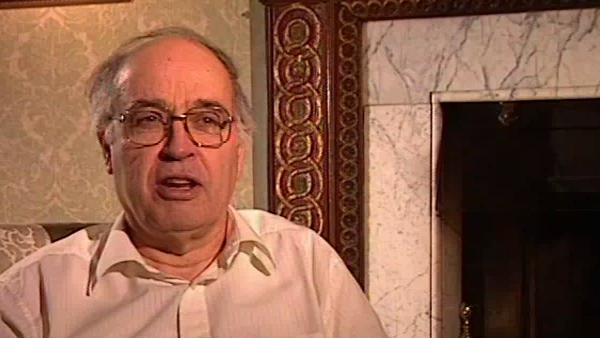NEXT STORY

Instanton
RELATED STORIES

NEXT STORY

Instanton
RELATED STORIES


|
Views | Duration | |
|---|---|---|---|
| 61. Lacunas and hyperbolic equations | 551 | 04:01 | |
| 62. Further research on lacunas | 443 | 02:36 | |
| 63. Instanton | 1 | 628 | 03:25 |
| 64. Evolving story of instantons | 528 | 02:38 | |
| 65. Almost beaten by Manin | 929 | 01:31 | |
| 66. Euclidian version of twistor theory | 636 | 02:08 | |
| 67. Collaborating with physicists | 1239 | 02:08 | |
| 68. The lack of a background in physics | 1 | 1229 | 02:02 |
| 69. Three manifold invariants | 790 | 02:55 | |
| 70. Individual contributions | 675 | 01:02 |


I kept my interest in hyperbolic equations for a while because, as I say, this programme took several years to keep going, and we wrote two big papers and... and then Gårding really wrote the third one more or less on his own, subsequently. And so when I was back in... in America I used to go to NYU quite a lot, because that was the kind of home of analysis – differential equations – there was Peter Lax and Louis Nirenberg and all these people, whom I got to know through Singer; they were friends. And so there… it was very useful to have all these analysts and I'd be invited up, usually when I was there to give a talk at NYU, and I used to make this joke that alternately I would talk about elliptic equations one year and hyperbolic equations the next year. So it... it gave me another link up with the differential equations community; which was quite useful.
But it was a bit on… it was a... it was a little team on its own, Bott and Gårding and me, we worked on this thing and I... I don't… I mean, I don't know, it wasn't part of a general major programme, we didn't have lots of other people coming in and joining us or anything. We... we cleaned up the problem to some extent. It's nice… it’s a nice account and it combines a good application of modern topology, algebraic geometry to differential equation theory. But it closes a chapter in some sense; although not entirely. Again, Hörmander suggested a generalisation of the notion of lacunas to Gårding, which Gårding used up, which was not to worry too much about things exactly being zero, but what happened as you approached… and so in particular Hörmander was emphasising the importance of doing things which worked also for differential equation with variable coefficients.
You see, these things which originally were differential equations with constant coefficients, where they're fully transformed, turned into good old-fashioned algebraic geometry and, you know, nice and clean. And most of the important equations are like that, the fundamental equations of physics are constant coefficients in some sense. But he wanted to do… he wanted to study more hyperbolic equations in a more realistic physical situation, and then they quite likely would have lower order terms and might have variable coefficients; and so you'd still want to know to what extent these lacuna questions would work. So Hörmander suggested that one should formulate the problem in that way; and so we did. And Gårding did pursue that a bit, so it did... did lead on a little... little bit further. But I don't know whether, you know, anybody else has picked that up.
So it was really a little digression of a kind, but again great fun. It involved this nice collaboration and I got… we got to know each other very well, and I've been to Sweden several times since, and they even gave me an honorary degree in Sweden…
Eminent British mathematician Sir Michael Atiyah (1929-2019) broke new ground in geometry and topology with his proof of the Atiyah-Singer Index Theorem in the 1960s. This proof led to new branches of mathematics being developed, including those needed to understand emerging theories like supergravity and string theory.
Title: Further research on lacunas
Listeners: Nigel Hitchin
Professor Nigel Hitchin, FRS, is the Rouse Ball Professor of Mathematics and Fellow of Gonville and Caius College, Cambridge, since 1994, and was appointed to the Savilian Professorship of Geometry in October 1997. He was made a Fellow of the Royal Society in 1991 and from 1994 until 1996 was President of the London Mathematical Society.
His research interests are in differential and algebraic geometry and its relationship with the equations of mathematical physics. He is particularly known for his work on instantons, magnetic monopoles, and integrable systems. In addition to numerous articles in academic journals, he has published "Monopoles, Minimal Surfaces and Algebraic Curves" (Presses de l'Universite de Montreal, 1987) and "The Geometry and Dynamics of Magnetic Monopoles" (Princeton University Press, 1988, with Michael Atiyah).
Tags: NYU, Sweden, Peter Lax, Louis Nirenberg, Isadore Singer, Lars Hormander, Lars Garding
Duration: 2 minutes, 37 seconds
Date story recorded: March 1997
Date story went live: 24 January 2008